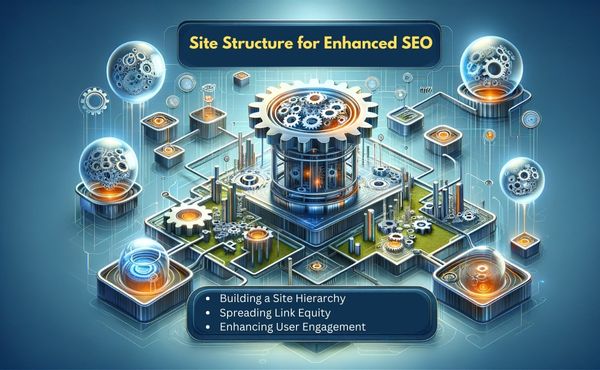Site Structure Optimization is a pivotal aspect of modern SEO and website design, impacting both a site’s visibility in search engine results and the overall user experience. This optimization process involves refining the website architecture, enhancing the clarity and coherence of the site’s layout, and ensuring that content is logically organized and easily navigable.
The significance of site structure optimization lies in its dual impact on both search engines and site visitors. For search engines, a well-structured site simplifies the processes of crawling and indexing, allowing for a more efficient and accurate assessment of the site’s relevance to specific search queries. This optimization directly influences a site’s ranking in search results, making it a crucial component of any SEO strategy.
From a user experience perspective, an optimized site structure ensures that visitors can intuitively navigate the website, find the information they need, and have a positive interaction with the site. This not only enhances user satisfaction but also contributes to longer site visits, lower bounce rates, and, ultimately, a higher likelihood of converting visitors into customers or followers.

Understanding the Basics of Site Structure
The concept of site structure pertains to the organization and framework of a website’s content. It’s a critical element that defines the ease with which both users and search engines can navigate a site. Understanding its basics is paramount for any successful SEO and user experience strategy.
Components of Site Structure
- Hierarchy and Navigation: This involves the arrangement of pages within the website. A logical hierarchy ensures that important pages are easily accessible, while navigation helps users move through the site with ease.
- URL Structure: The URLs should be clear, concise, and reflective of the site’s hierarchy. SEO-friendly URL structuring aids in better indexing by search engines.
- Internal Linking: This strategy links various pages of a website, indicating the relationship between different content pieces and improving site navigation.
- Categories and Tags: For content-rich sites, categories and tags help in organizing articles or products in a coherent manner, enhancing discoverability.
- Sitemaps: Both XML and HTML sitemaps assist search engines and users in understanding the structure and content of the site.
Impact on SEO and User Experience
A well-organized site structure impacts SEO by:
- Enhancing the crawlability for search engines, thereby aiding in better indexing.
- Improving the distribution of page authority and ranking power throughout the site.
- Facilitating keyword optimization, particularly in URL structures and internal linking strategies.
For users, a good site structure translates to:
- Easier navigation, leading to a more intuitive user experience.
- Reduced confusion and lower bounce rates, as users find what they need quickly.
- Enhanced satisfaction, leading to higher engagement and conversion rates.
The foundation of a successful website lies in a well-thought-out site structure that caters to both search engine algorithms and user needs. It’s not merely about creating content but about how that content is structured, linked, and presented to the world.

How Search Engines Utilize Site Structure
The role of site structure in the realm of search engine optimization (SEO) is often underappreciated, yet it’s a cornerstone of how search engines understand and rank websites. Let’s explore the crucial functions of crawling, indexing, and ranking, and their interplay with site structure.
The Crawling Process
- Discovery of Content: Search engines, like Google, initiate the crawling process by discovering a website, often starting from the homepage.
- Link Exploration: Crawlers then navigate the site, following internal links to explore and document the content across different pages.
- Understanding Site Hierarchy: The structure of a site, revealed through its navigation and linking patterns, helps search engines determine the relationship between various pages and the overall importance of each page within the site.
Indexing and Understanding Content
Once a search engine crawls a website, the next step is indexing. Here, the site structure plays a pivotal role in:
- Content Categorization: A clear site structure allows search engines to categorize content effectively, understanding the primary focus and themes of the site.
- Hierarchy of Information: The organization of content into categories and subcategories helps in recognizing the hierarchy of information, which is crucial for indexing.
Impact on Ranking
A well-structured website can significantly impact its ranking in search results:
- Enhanced Relevance and Authority: A logical site structure contributes to perceived relevance and authority in a given niche or subject area.
- Opportunities for Featured Snippets: Organized content with clear headings and a logical flow is more likely to be picked up for featured snippets in search results.
- User Engagement Signals: Search engines consider user behavior, such as time spent on site and bounce rates, as ranking factors. A user-friendly site structure encourages longer visits and deeper engagement, sending positive signals to search engines.
An optimized site structure is not just about pleasing search engine algorithms. It’s a fundamental aspect of communicating a website’s purpose, relevance, and value, both to the algorithms that rank content and the users who consume it.

Optimizing Site Structure for Enhanced SEO
Optimizing a website’s structure is a strategic process that enhances its SEO potential. Here, we’ll explore the critical areas of internal linking, URL structuring, and the impact of site structure on Google’s featured snippets.
Internal Linking Strategies and Their SEO Benefits
- Building a Site Hierarchy: Thoughtful internal linking helps establish a clear hierarchy on your site, guiding search engines to prioritize your main pages.
- Spreading Link Equity: Links from high-authority pages to less visible ones distribute ‘link equity,’ boosting the SEO value of the linked pages.
- Enhancing User Engagement: Strategic links keep users engaged, reducing bounce rates and increasing time spent on the site, both positive signals to search engines.
The Role of URL Structure in SEO
- Clear and Concise URLs: URLs that reflect the site’s hierarchy and content topic help search engines understand the page’s context.
- Inclusion of Keywords: Including relevant keywords in URLs aids in aligning with user search queries, enhancing visibility.
- Readability for Users and Crawlers: Well-structured URLs, devoid of confusing parameters or excessive length, improve readability for both users and crawlers.
Impact of Site Structure on Google’s Featured Snippets
- Structured and Organized Content: Content organized under clear, descriptive headings increases the chances of being featured in Google’s snippets.
- Answer-focused Segments: Providing concise, direct answers to common queries within your content can lead to snippet features, increasing visibility and click-through rates.
- Hierarchical Formatting: Using a logical hierarchy in your content, with a mix of H2s and H3s, makes it easier for Google to extract and feature the most relevant information.
In essence, optimizing site structure for SEO is not merely about tweaking technical elements but about creating a seamless and intuitive journey for both search engines and users. It’s about ensuring that your valuable content is discovered, understood, and appropriately ranked.

Practical Steps for Site Structure Optimization
Optimizing your site’s structure is a deliberate process that requires careful planning and execution. Here are practical steps for optimizing the site structure of both new and existing websites, ensuring effective use of categories and tags, and implementing of breadcrumb navigation.
Planning the Site Structure for New and Existing Websites
- For New Websites:
- Start with a Clear Hierarchy: Design your site’s architecture with a logical hierarchy, keeping the depth to a maximum of three levels.
- User-Centric Categories: Develop categories based on user intent and search behavior, ensuring they are comprehensive and mutually exclusive.
- For Existing Websites:
- Website Content Audits: Regularly review your site structure for any inefficiencies or redundancies.
- Evolve with User Needs: Adapt your site structure based on analytics data, user feedback, and SEO performance.
Effective Use of Categories and Tags for Content Organization
- Balanced Categories: Ensure your categories are evenly distributed, neither too broad nor too narrow, and reflect the core topics of your site.
- Strategic Use of Tags: Tags should be used to describe specific details of your content, helping in fine-tuning the content discovery process.
Implementing Breadcrumb Navigation and Its SEO Benefits
- Clear Pathways: Breadcrumbs provide a clear path back to the homepage from any page on the site, improving user navigation.
- SEO Advantage: Breadcrumbs also enhance SEO by providing search engines with another layer of information about the site’s structure.
By taking these practical steps, you can ensure that your site’s structure is not only optimized for search engines but also provides a smooth and intuitive experience for your users.
Maintaining an Effective Website Structure Over Time
Maintaining an effective site structure is an ongoing process, crucial for sustaining SEO performance and user engagement. Here are key strategies for regular evaluation, updates, and avoiding common pitfalls like keyword cannibalization.
Regular Evaluation and Updating of Site Structure
- Periodic Reviews: Conduct regular audits to assess the effectiveness of your site structure, ensuring it aligns with current SEO best practices and user expectations.
- Adapt to Changes: Be ready to modify your structure in response to changes in your content strategy, user behavior, or search engine algorithms.
Avoiding Common Pitfalls like Keyword Cannibalization
- Identify Overlaps: Regularly check for content that targets similar keywords, which can lead to competition between your own pages.
- Consolidate or Differentiate Content: Merge similar content that competes for the same keywords or differentiate them to target distinct aspects of the topic. Finding these overlapping keywords and content can be difficult when working with medium to large websites. That’s why I always recommend completing a full website content audit at least once a year.
By staying vigilant and responsive to these factors, you can ensure your site structure remains effective and conducive to both SEO and a positive user experience.
The Future of Site Structure and SEO
As we advance into the future, the importance of site structure in SEO is poised to grow even further. The evolving algorithms of search engines increasingly value user experience, making a well-organized site more crucial than ever.
Here are some final thoughts on site structure and SEO:
- Continual Adaptation: The digital landscape is constantly evolving. Staying abreast of changes in search engine algorithms and user behavior is vital for maintaining an effective site structure.
- User-Centric Approach: The future of SEO is increasingly user-focused. A site structure optimized for user experience is likely to perform better in search engine rankings.
- Technological Advancements: As new technologies emerge, such as voice search and AI, adapting your site structure to accommodate these changes will be essential.
In conclusion, site structure optimization is not just a foundational aspect of SEO today; it’s a dynamic component that will continue to shape the success of websites in the digital realm. Keeping your site structure aligned with both search engine requirements and user needs is the key to long-term success.
FAQs on Site Structure
Ideally, review your site structure semi-annually or annually. However, if you make significant changes to your content or notice a drop in SEO performance, it’s wise to conduct a review sooner.
Absolutely. A poorly organized site can lead to difficulties in crawling and indexing by search engines, negatively impacting your SEO. It also hinders user experience, potentially increasing bounce rates.
Not necessarily every page, but your homepage should link to all major categories. The “three-click rule” is a good practice, where users can find any information within three clicks from the homepage.
Very important. Breadcrumbs not only enhance user navigation but also provide search engines with another layer of hierarchy, helping them understand the structure and content of your site.
Identify pages that compete for the same keywords and either merge them or differentiate their focus. Ensure your internal linking strategy supports this differentiation.

